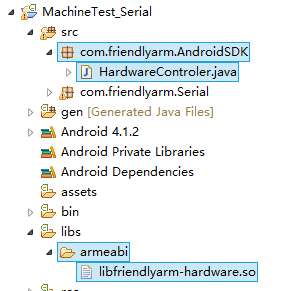210开发板Android系统串口程序
最近由于项目需要,花了两天时间在Android平台下编写了一个串口助手软件。硬件平台是友善之臂的tiny210开发板。起初的想法是首先基于Linux驱动做一些修改,然后自行编写HAL层代码,最后编写Android应用程序调用HAL Stub来实现和串口通信。后来在网上看到友善之臂为Android系统操作硬件资源专门开发了一个库文件:libfriendlyarm-hardware.so,通过它我们可以很方便的操作串口。于是对这个文件深入了解了一下。
网上可以搜出很多关于这个文件用法的博客,但是全部都是同样的内容,也不知谁是原创。并且博客中的代码个人觉得有些地方略显多余,亲测了一下,串口程序会有明显的卡顿(也许是本人开发板硬件条件问题),于是自己按照官方的接口说明编写了一个程序。测试通过之后总算搞定,现在把我的过程和源代码分享给大家,希望能帮到大家。(工程源码GitHub地址见文章结尾处)
1、硬件连接
首先我们要用串口线连接PC和开发板,注意需要用交叉线相连。可以用友善自带Android系统中的串口助手测试一下,保证串口的线路通畅
2、部署库文件
这里按照配套光盘里的开发板用户手册4.2.1节介绍的方法部署(点击可下载)。
- 首先进入工程目录,在libs文件下新建armeabi文件夹,然后把libfriendlyrm-hardware.so文件放入此文件夹下。
-
然后在eclipse中src目录下新建一个包,包名为com.friendlyarm.AndroidSDK,并新建名为HardwareControler.java的文件,写入以下内容:
package com.friendlyarm.AndroidSDK; import android.util.Log public class HardwareControler { //Serial Port static public native int openSerialPort( String devName, long baud, int dataBits, int stopBits ); static public native int write(int fd, byte[] data); static public native int read(int fd, byte[] buf, int len); static public native int select(int fd, int sec, int usec); static public native void close(int fd); static { try { System.loadLibrary("friendlyarm-hardware"); } catch (UnsatisfiedLinkError e) { Log.d("HardwareControler", "libfriendlyarm-hardware library not found!"); } } }部署完后,右键工程→fresh,可以看到如下图所示选中的四个文件:
-
接下来就可以新建我们的应用代码了。在代码开头导入 com.friendlyarm.AndroidSDK.HardwareControler就可以。
3、布局文件
工程比较简单,这里只需要一个布局文件即可。我只用了一个接收显示区,一个发送显示区和关闭、打开、发送、清空四个按钮。布局文件代码如下:
<LinearLayout xmlns:android="http://schemas.android.com/apk/res/android"
xmlns:tools="http://schemas.android.com/tools"
android:baselineAligned="false"
android:layout_width="match_parent"
android:layout_height="match_parent"
android:orientation="horizontal"
android:paddingBottom="@dimen/activity_vertical_margin"
android:paddingLeft="@dimen/activity_horizontal_margin"
android:paddingRight="@dimen/activity_horizontal_margin"
android:paddingTop="@dimen/activity_vertical_margin"
tools:context=".HardwareControler"
android:background="@android:color/holo_green_dark">
<LinearLayout
android:layout_width="match_parent"
android:layout_height="match_parent"
android:layout_weight="1"
android:orientation="vertical" >
<TextView
android:layout_width="wrap_content"
android:layout_height="wrap_content"
android:text="@string/receive_textview" />
<TextView
android:id="@+id/rev_tv"
android:layout_width="match_parent"
android:layout_height="match_parent"
android:background="@android:color/darker_gray" />
</LinearLayout>
<LinearLayout
android:layout_width="match_parent"
android:layout_height="match_parent"
android:layout_marginLeft="10dp"
android:layout_weight="1"
android:orientation="vertical" >
<TextView
android:layout_width="wrap_content"
android:layout_height="wrap_content"
android:text="@string/send_edittext" />
<EditText
android:hint="@string/data_to_send"
android:id="@+id/send_et"
android:layout_width="match_parent"
android:layout_height="60dp"
android:background="@android:color/darker_gray" />
<RelativeLayout
android:layout_width="match_parent"
android:layout_height="match_parent"
android:gravity="center"
android:orientation="horizontal" >
<Button
android:id="@+id/openSerial_bt"
android:layout_width="wrap_content"
android:layout_height="wrap_content"
android:layout_margin="20dp"
android:text="@string/open_serial" />
<Button
android:id="@+id/closeSerial_bt"
android:layout_width="wrap_content"
android:layout_height="wrap_content"
android:layout_toRightOf="@id/openSerial_bt"
android:layout_alignTop="@id/openSerial_bt"
android:text="@string/close_serial"
android:enabled="false" />
<Button
android:id="@+id/sendSerial_bt"
android:layout_width="wrap_content"
android:layout_height="wrap_content"
android:layout_alignLeft="@id/openSerial_bt"
android:layout_below="@id/openSerial_bt"
android:text="@string/send_data" />
<Button
android:id="@+id/clear_bt"
android:layout_marginLeft="20dp"
android:layout_width="wrap_content"
android:layout_height="wrap_content"
android:layout_alignTop="@id/sendSerial_bt"
android:layout_toRightOf="@id/sendSerial_bt"
android:text="@string/clear_data" />
</RelativeLayout>
</LinearLayout>
</LinearLayout>我使用的是7寸的横屏,大家可以按照自己的屏幕来适配不同的代码。
4、Java代码编写
首先需要了解库文件为我们提供的接口函数,文档里有详细的解释:
- int openSerialPort( String devName, long baud, int dataBits, int stopBits )
打开指定的串口设备,并返回文件描述符。 - int write( int fd, byte[] data)
向打开的设备或文件中写数据。 - int read( int fd, byte[] buf, int len)
从打开的设备或文件中读取数据。buf是接收缓存,len是需要接收的字节数,函数返回实际接收的字节数。 - int select( int fd, int sec, int usec)
查询打开的设备或文件是否有数据可读。 - void close(int fd)
关闭指定的文件描述符。
代码说明:
首先用户点击打开按键,此时会开启监听进程通过select函数不断监听是否有数据进来,如果有,则通过handler发送消息通知主线程显示。如下:
openSerial.setOnClickListener(new Button.OnClickListener()
{
@Override
public void onClick(View v)
{
fd = HardwareControler.openSerialPort("/dev/s3c2410_serial3",
115200, 8, 1);
openFlag = true;
Toast.makeText(getApplicationContext(),
getString(R.string.open_sucssess), Toast.LENGTH_SHORT)
.show();
openSerial.setEnabled(false);
closeSerial.setEnabled(true);
/**
* 启动线程监听数据
*/
listen = new Thread(new Runnable()
{
@Override
public void run()
{
while (openFlag)
{
int m = HardwareControler.select(fd, 2, 20);
int n;
String text = "";
if (m == 1)
{
while ((n = HardwareControler.read(fd, buf,
buf.length)) > 0)
{
try
{
Thread.sleep(90); // 睡眠等待数据完全接收
} catch (InterruptedException e)
{
e.printStackTrace();
}
for (int i = 0; i < n; i++)
{
text += (char) buf[i];
}
};
Log.d("MC", "n:" + n);
Message message = Message.obtain();
message.obj = text;
revHandler.sendMessage(message);
System.out.println(Arrays.toString(buf));
}
try
{
Thread.sleep(1000);
} catch (InterruptedException e)
{
e.printStackTrace();
}
}
}
});
listen.start();
}
});这里需要注意的是:在while反复判断read返回值时,需要有一个短暂的睡眠以等待数据全部进入串口驱动程序,否则会出现数据间断的情况。此时,用户可以随时通过发送按键讲发送框里的数据发送出去,代码如下:
public void SendSerial()
{
HardwareControler.write(fd, send_et.getText().toString().getBytes());
}
/**
* 发送数据
*/
sendSerial.setOnClickListener(new Button.OnClickListener()
{
public void onClick(View v)
{
SendSerial();
}
});最后关闭串口:
/**
* 关闭串口
*/
closeSerial.setOnClickListener(new Button.OnClickListener()
{
@Override
public void onClick(View v)
{
HardwareControler.close(fd);
openFlag = false;
openSerial.setEnabled(true);
closeSerial.setEnabled(false);
Toast.makeText(getApplicationContext(),
getString(R.string.close_sucssess), Toast.LENGTH_SHORT)
.show();
}
});到这里,基本的功能已经全部实现,亲测之后对于功能上还算过关,界面比较粗糙。欢迎各位朋友对代码进行修正补缺,有什么问题也可以给我留言,一起探讨。
tiny210开发板用户手册下载:
http://yun.baidu.com/share/link?shareid=2019636114&uk=67973003
apk下载链接:
http://yun.baidu.com/share/link?shareid=2360935897&uk=67973003
GitHub源码下载链接:
https://github.com/hust-MC/Android-Serial.git
